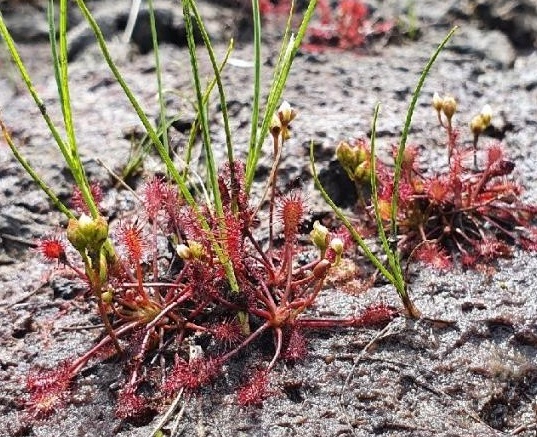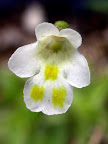 Pinguicula alpina L. (Syn.: Pinguicula flavescens Florke ex Hoppe, P. gellida Schur, P. pallia Turcz., P. villosa Gunner)
Pinguicula alpina L. (Syn.: Pinguicula flavescens Florke ex Hoppe, P. gellida Schur, P. pallia Turcz., P. villosa Gunner)
Carnivorous plant Pinguicula alpina, also known as the „alpine butterwort“, is smaller perennial herb belonging to group of homophyllous temperate butterworts, however, with some interesting specifics within the genus.
The taxonomic classification of Pinguicula alpina is in Family Lentibulariaceae, Tribe Lecantheae, Genus Pinguicula, Subgenus Temnoceras, Section Micranthes (for species included in this section is one of the unusual feature – affixed hibernaculum, hibernaculum with roots), to which is classified along with P. algida, P. ramosa and P. variegata. But it is only Pinguicula alpina which keeps his roots on the winter hibernacula.
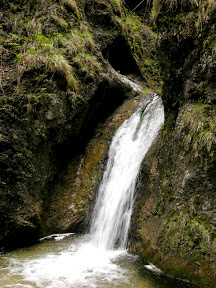
P. alpina growing places, Slovakia
Alpine butterwort generally inhabits very wet places from lowlands (sea level – subarctic regions, NW Siberia), through sites in the lower mountain altitudes (from 400 to 1000 m – Finland, Norway, Italy, Switzerland, Slovenia etc.) to (sub)alpine mountain areas (for example in Pyrenees, Alps, Karpates and in the alpine heights of Himalayas, at 3000 – 4400 m, from Kashmir to Sikkim, Kumaun Himalaya in the Central Himalaya etc.). No other species of Pinguicula genus does not occur in such a range of altitude and latitude.
On natural habitats Pinguicula alpina grows in different kinds of soils (can be found on calcareous soils but also on silicate soils and is the only species from section Micranthes that tolerates both types of soils) as for example, boggy places, bogs with Sphagnum moss, „acidic“ alpine rock-meadows on springy slopes and other wet places including wet bluffs and rocks, calcareous sandstone, limestone with calcareous mosses and limestone soils (it is very likely that some populations are „strictly, obligatory calcareous“ where plants prefers wet soils with alkali to neutral pH).
Habitats may vary from shady to full sun exposition.
The plant leaves rosette, which is ground-hugging and up to 8 cm in diameter, it consists of several fleshy, from light-green, yellow-green, reddish to dark red, from elliptic to lanceolate glandular carnivorous leaves. It is interesting that the population of red plants I found only in southern Europe (for example in Slovenia and Italy).
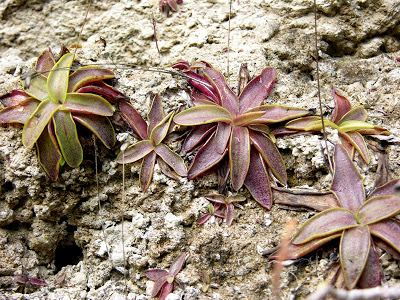
Red-leaves form of Pinguicula alpina in Italy
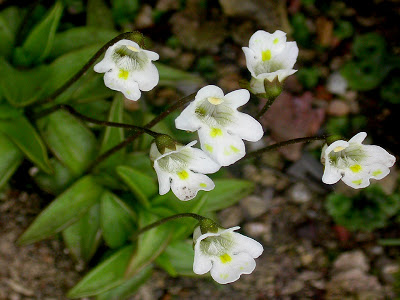
Green leaves form in Slovakia
The variability in leaf coloration is rather wide and similar situation is also in case of yellow spots (more precisely the size, shape and numer) on lower lip of white zygomorphic flowers.
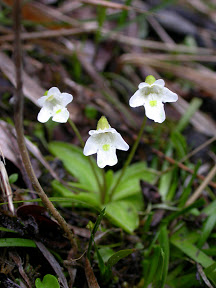 For some population of P. alpina in Slovakia lower lip with 3 yellow spots is very typical, in some population of Norway or Switzerland were found plants flowers of different variants from one little spot to one bigger spot in the inverted „Y” and plants from „red leaves“ population has very often bloom narrower or wider flowers contrast with one strong central spot (it is possible to work with the idea of a possible relationship pollinators and spots, but it’s just unconfirmed assumption).
For some population of P. alpina in Slovakia lower lip with 3 yellow spots is very typical, in some population of Norway or Switzerland were found plants flowers of different variants from one little spot to one bigger spot in the inverted „Y” and plants from „red leaves“ population has very often bloom narrower or wider flowers contrast with one strong central spot (it is possible to work with the idea of a possible relationship pollinators and spots, but it’s just unconfirmed assumption).
According to conditions in which alpine butterwort grows in the natural sites, there can be extrapolated conditions suitable for growing. Growth period usually begins in May and ends in 3 – 5 months. Plants grow in high humidity, ample light and temperatures up to 20°C (max 28°C, but only in short time!). As a media I use soft porous travertine or mix of travertine, sand and peat. Plants can be grown during the whole year in the garden.
More pictures to this article.
References:
1. Legendre L (2002). „The genus Pinguicula L. (Lentibulariaceae): an overview”. Acta Botanica Gallica 141 (1): 77–95. http://www.pinguicula.org/pages/culture/Overview.htm;
2. Casper S. J., Eine neue Pinguicula-Art aus Mexico; Feddes Repert., Band 85, Heft 1-2, Berlin (1974);
3. D’Amato P (1988). The savage garden: cultivating carnivorous plants. Ten Speed Press. ISBN ISBN 0-89815-915-6;
4. Steiger J. F., Dauerkultur von Fettkraut (Pinguicula) und Sonnentau (Drosera) im eigenen Garten; Leben und Umwelt, 1960, Nr. 8;
5. http://encyclo.free.fr/pages/ping_01.htm – Les PINGUICULA de climat tempéré et leur culture, après un texte du Dr Jürg F. STEIGER (CPN VOL. IV N°1 1975);
(Traduction et mise en forme libre E. PARTRAT parue dans Dionée 41 en 1999);
6. http://www.pinguicula.org/pages/plantes/pinguicula_alpina.htm – Pinguicula alpina;
7. http://www.indianetzone.com/5/flora_uttaranchal.htm – Flora Of Uttarakhand;
8. http://himalaya.socanth.cam.ac.uk/collections/rarebooks/downloads/Tilman_Nepal_Himalaya.pdf – NEPAL HIMALAYA, H. W. TILMAN, Cambridge, 1952;
9. http://www.treknature.com/gallery/Europe/Norway/North/Troms/photo141345.htm – Yunnan Highlands:, hoes of Home, Timothy Lever;
10. Project Lifescape – 11, Hunter plants Dipanjan Ghosh, Centre of Advanced Study, Department of Botany, Calcutta University, 35, Ballygunge Circular Road, Calcutta 700019, India;
11. Mani Raj Shrestha, Maan B. Rokaya and Suresh Kumar Ghimire (2006): A Checklist of Trans-Himalayan Dicot Flora of Dolpo and Its Surrounding Region in Northwest Nepal, Scientific World, HMG / Nepal. Vol. 4, Number 4, July 2006.
David Svarc
Czech Republic
